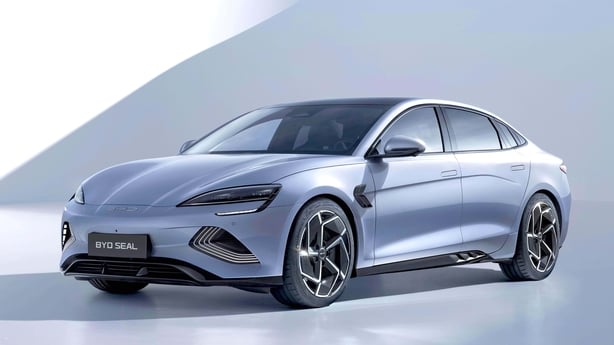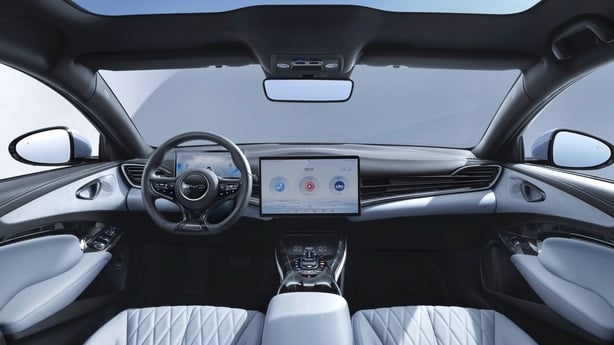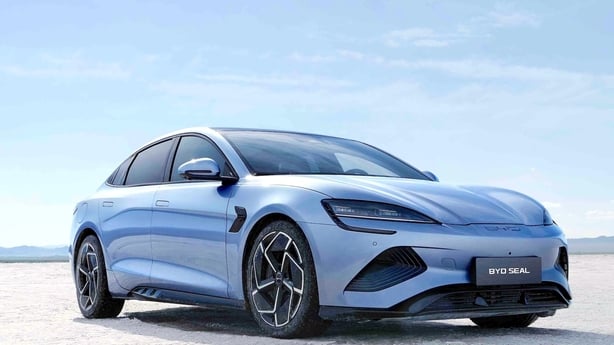The Chinese cars we've seen arriving in Ireland so far have tended to be more of the budget variety, well equipped and priced to sell. Now BYD has introduced the executive car it hopes will tilt at similar offerings from Tesla, Hyundai and others - the Seal.
What perhaps most distinguishes the Seal from others is its low profile. It’s long and sleek and has a sloping roofline to assist with reducing drag and achieving better electric consumption.
As a first offering, its styling serves it well and is sufficiently bold to turn heads and attract quite a few observations and enquiries, as I discovered when driving it. Several people were drawn to its rather sweeping lines, offset by large wheels. And they loved the 15.6" screen.

Initially, the car looks and feels lighter than some of its competitors - notably Polestar. When you look at the figures, however, you discover that BYD’s Blade battery configuration still carries a weight penalty - the Seal entry level version comes in at two tonnes. This isn’t a weight load conducive to sharp handling and the car does tend to wallow a bit in this regard.
The sloping roofline does allow the car to achieve an impressive drag factor of 0.22, which simply means there is better capacity to allow wind to flow over the car with much less resistance. That also means, however, that the roofline does impinge on rear head room.
It’s OK for two rear seat passengers but it’s not as accommodating as I thought when I first drove the car briefly. Rear legroom is also a bit compromised as is the legroom for taller drivers. The driver seat travel isn’t long enough to ensure absolute comfort.
The boot is a fairly generous 400 litres but the boot opening isn’t as generous and its ease of loading is not what it should be.
The Seal is primarily designed for comfort and engineered accordingly. At lower speeds on mixed surfaces the ride can be abit less refined and that weight doesn't help.
Out on the motorway the Seal comes into its own as a cruiser, albeit with some wind noise. Overall though, the car delivers a very smooth and pleasant driving experience.

The basic battery is an 82.5 kWh unit, which is a bigger capacity than you’ll get from say a standard VW ID4 or even a Tesla Model 3. It does deliver well on consumption, with the car good for about 450 km’s in reasonably clement conditions.
For example, my available range with an 85 per cent charge was 445 km’s and then 392 at 75 per cent and 200 km’s at 39 per cent and a fair amount of motorway driving was involved. No great worries there then.
Average consumption tended to be in or around 17.8 kWh per 100 kilometres, which is pretty good but not quite as good as that of the Hyundai Ioniq 6 on a long journey.
Charging capacity is limited to 150 kWh so, if you are lucky enough to get a greater output than that your charging time will be a bit extra.
There were some issues, some of them a bit more than annoying.
The Seal has a BYD signature 15.6" centre screen that is a major selling point, especially when people see how it rotates from portrait to landscape - it’s very impressive.
However, there are simply too many menus and too few buttons and controls. I really don’t believe having to rely on screens for basic functions when you’re driving is a good or a safe idea. Many manufacturers are doing the same with their cars, pushing the attraction of digital over conventional. It’s distracting and often annoying.
The secondary screen, which gives you your basic information, is too cluttered with small and hard to read icons. It’s over-populated and its screen resolution also means you are looking at more of your reflected face than the information you want.

Then there were software issues. I couldn’t understand why the car’s voice warning repeatedly told me I was exceeding the speed limit when I was driving at 85 kph on a 100 km/h route, until I noticed the car’s speed limit recognition was fixed on a maximum of 50 kph. Even approaching speed signs with a clear front view didn’t help. On the other hand, recognition of a 30 kph zone was instantaneous. One assumes an over the air software fix is required.
The car’s voice recognition system wasn't that helpful either, and on more than one occasion it was defeated by my clearly voiced instructions.
The interior is bright and spacious and a 1.3 square metre panoramic roof is standard. The blend of plastics, suede and "vegan" leather is well managed to create a very pleasant driving ambience. Don’t expect to experience a true leather feeling with this material, however.
Despite these irritations, I liked the Seal, its price and its range. BYD may not have the cachet of other big brand names but it does offer every conceivable safety and comfort feature and a five star EuroNCAP crash test performance. There’s a six year warranty with the car and an eight year warranty on the battery.
If the menus hadn’t presented such a challenge, I’d have liked the car a lot more.

